Quantifying Household Water Use and Its Determinants in Low-Income, Water-Scarce Households in Karachi
Abstract
:1. Introduction
2. Materials and Methods
2.1. Study Area: Lyari Township
2.2. Methods
3. Results
3.1. Seasonal Variation
3.2. Sociodemographic Variation
3.3. Socioeconomic Variation
3.4. Water Supply Variation
3.5. Perceptions of Sufficiency
4. Discussion
5. Conclusions
Author Contributions
Funding
Institutional Review Board Statement
Informed Consent Statement
Data Availability Statement
Conflicts of Interest
References
- Flörke, M.; Schneider, C.; McDonald, R.I. Water Competition between Cities and Agriculture Driven by Climate Change and Urban Growth. Nat. Sustain. 2018, 1, 51–58. [Google Scholar] [CrossRef]
- Nauges, C.; Whittington, D. Estimation of Water Demand in Developing Countries: An Overview. World Bank Res. Obs. 2010, 25, 263–294. [Google Scholar] [CrossRef]
- Vairavamoorthy, K.; Gorantiwar, S.D.; Pathirana, A. Managing Urban Water Supplies in Developing Countries—Climate Change and Water Scarcity Scenarios. Phys. Chem. Earth Parts ABC 2008, 33, 330–339. [Google Scholar] [CrossRef]
- Pesantez, J.E.; Berglund, E.Z.; Kaza, N. Smart Meters Data for Modeling and Forecasting Water Demand at the User-Level. Environ. Model. Softw. 2020, 125, 104633. [Google Scholar] [CrossRef]
- Edwards, K.; Martin, L. A Methodology for Surveying Domestic Water Consumption. Water Environ. J. 1995, 9, 477–488. [Google Scholar] [CrossRef]
- Kim, S.H.; Choi, S.H.; Koo, J.Y.; Choi, S.I.; Hyun, I.H. Trend Analysis of Domestic Water Consumption Depending upon Social, Cultural, Economic Parameters. Water Supply 2007, 7, 61–68. [Google Scholar] [CrossRef]
- Abraham, S.; Diringer, S.; Cooley, H. An Assessment of Urban Water Demand Forecasts in California; Pacific Institute: Oakland, CA, USA, 2020; p. 16. [Google Scholar]
- Heberger, M.; Donnelly, K.; Cooley, H. A Community Guide for Evaluating Future Urban Water Demand; Pacific Institute: Oakland, CA, USA, 2016; p. 48. [Google Scholar]
- Anand, N. Hydraulic City: Water and the Infrastructures of Citizenship in Mumbai; Duke University Press: Durham, NC, USA; London, UK, 2017; ISBN 978-0-8223-6254-8. [Google Scholar]
- KWSB. Water Management—KWSB 2022; KWSB: Karachi, Pakistan, 2022. [Google Scholar]
- Janjua, S.; Hassan, I.; Ali, M.U.; Ibrahim, M.M.; Zafar, A.; Kim, S. Addressing Social Inequality and Improper Water Distribution in Cities: A Case Study of Karachi, Pakistan. Land 2021, 10, 1278. [Google Scholar] [CrossRef]
- Rizavi, T. Investing in Karachi. Available online: https://www.thenews.com.pk/print/885102-investing-in-karachi (accessed on 31 August 2022).
- Fan, L.; Wang, F.; Liu, G.; Yang, X.; Qin, W. Public Perception of Water Consumption and Its Effects on Water Conservation Behavior. Water 2014, 6, 1771–1784. [Google Scholar] [CrossRef]
- Shaban, A.; Sharma, R.N. Water Consumption Patterns in Domestic Households in Major Cities. Econ. Polit. Wkly. 2007, 42, 9. [Google Scholar]
- JICA. Study on Water Supply and Sewerage System in Karachi; JICA: Tokyo, Japan, 2008. [Google Scholar]
- Abdullah, R. The Role of Private Vending in Developing Country Water Service Delivery: The Case of Karachi, Pakistan. Master’s Dissertation, Massachusetts Institute of Technology, Cambridge, MA, USA, 1999. [Google Scholar]
- Anand, N. PRESSURE: The PoliTechnics of Water Supply in Mumbai. Cult. Anthropol. 2011, 26, 542–564. [Google Scholar] [CrossRef]
- Fletcher, S.; Strzepek, K.; Alsaati, A.; Weck, O. de Learning and Flexibility for Water Supply Infrastructure Planning under Groundwater Resource Uncertainty. Environ. Res. Lett. 2019, 14, 114022. [Google Scholar] [CrossRef]
- Fluence Sydney’s White Elephant Desalination Plant. Available online: https://www.fluencecorp.com/white-elephant-desalination-plant/ (accessed on 2 September 2022).
- Khan, H.F.; Arshad, S.A. Beyond Water Scarcity: Water (in)Security and Social Justice in Karachi. J. Hydrol. Reg. Stud. 2022, 42, 101140. [Google Scholar] [CrossRef]
- Donkor, E.A.; Mazzuchi, T.A.; Soyer, R.; Alan Roberson, J. Urban Water Demand Forecasting: Review of Methods and Models. J. Water Resour. Plan. Manag. 2014, 140, 146–159. [Google Scholar] [CrossRef]
- Baigorri, B.; Montañés, A.; Simón-Fernández, M.B. Household Water Consumption in Spain: Disparities between Region. Water 2022, 14, 1121. [Google Scholar] [CrossRef]
- Basu, M.; Hoshino, S.; Hashimoto, S.; DasGupta, R. Determinants of Water Consumption: A Cross-Sectional Household Study in Drought-Prone Rural India. Int. J. Disaster Risk Reduct. 2017, 24, 373–382. [Google Scholar] [CrossRef]
- Adams, E.A. Intra-Urban Inequalities in Water Access among Households in Malawi’s Informal Settlements: Toward pro-Poor Urban Water Policies in Africa. Environ. Dev. 2018, 26, 34–42. [Google Scholar] [CrossRef]
- Mutono, N.; Wright, J.; Mutembei, H.; Thumbi, S.M. Spatio-Temporal Patterns of Domestic Water Distribution, Consumption and Sufficiency: Neighbourhood Inequalities in Nairobi, Kenya. Habitat Int. 2022, 119, 102476. [Google Scholar] [CrossRef]
- Anwar, N.H.; Khan, H.F.; Abdullah, A.; Macktoom, S.; Fatima, A. Designed to Fail? Heat Governance in Urban South Asia: The Case of Karachi a Scoping Study; Cool Infrastructures: Life with Heat in the Off-grid City: Karachi; University of Edinburgh: Edinburgh, UK, 2022; p. 48. [Google Scholar]
- Anwar, N.H.; Sawas, A.; Mustafa, D. ‘Without Water, There Is No Life’: Negotiating Everyday Risks and Gendered Insecurities in Karachi’s Informal Settlements. Urban Stud. 2020, 57, 1320–1337. [Google Scholar] [CrossRef]
- Syvrud, A.; Pohlner, H.; Punthakey, J.F.; Grant, M.; Green, T. Advancing Urban Water Security in the Indus Basin, Pakistan—Priority Actions for Karachi and Lahore. Water 2021, 13, 3399. [Google Scholar] [CrossRef]
- Price, H.; Adams, E.; Quilliam, R.S. The Difference a Day Can Make: The Temporal Dynamics of Drinking Water Access and Quality in Urban Slums. Sci. Total Environ. 2019, 671, 818–826. [Google Scholar] [CrossRef]
- Di Mauro, A.; Cominola, A.; Castelletti, A.; Di Nardo, A. Urban Water Consumption at Multiple Spatial and Temporal Scales. A Review of Existing Datasets. Water 2020, 13, 36. [Google Scholar] [CrossRef]
- Beard, V.A.; Mitlin, D. Water Access in Global South Cities: The Challenges of Intermittency and Affordability. World Dev. 2021, 147, 105625. [Google Scholar] [CrossRef]
- Mustafa, D.; Gioli, G.; Karner, M.; Khan, I. Contested Waters: Subnational Scale Water Conflict in Pakistan; Peaceworks; United States Institute of Peace: Washington, DC, USA, 2017. [Google Scholar]
- Saleem, A.; Toheed, M.; Arif, M. Karachi—Housing without a Future?: More Than 60 Percent of Karachi’s Population Lives in Katchi Abadis or Informal Settlements. Available online: https://www.thenews.com.pk/tns/detail/621740-karachi-housing-without-a-future (accessed on 1 September 2022).
- PPP Senator Urges to Resolve Acute Water Shortage Issue of Lyari. Available online: https://nation.com.pk/2022/04/25/ppp-senator-urges-to-resolve-acute-water-shortage-issue-of-lyari/ (accessed on 20 October 2022).
- “We Are Not Treated like Humans”: Lyari’s Struggle for Water—Pakistan. Available online: https://dunyanews.tv/en/Pakistan/435359-We-are-not-treated-like-humans-Lyaris-struggle-for-water (accessed on 20 October 2022).
- Pakistan Bureau of Statistics Final Census Results. Available online: https://www.pbs.gov.pk/content/final-results-census-2017 (accessed on 16 July 2023).
- Gayer, L. Ordered Disorder and the Struggle for the City; Hurst and Co. Publishers: New Delhi, India, 2014. [Google Scholar]
- Ivankova, N.V.; Creswell, J.W.; Stick, S.L. Using Mixed-Methods Sequential Explanatory Design: From Theory to Practice. Field Methods 2006, 18, 3–20. [Google Scholar] [CrossRef]
- Singh, O.; Turkiya, S. A Survey of Household Domestic Water Consumption Patterns in Rural Semi-Arid Village, India. GeoJournal 2013, 78, 777–790. [Google Scholar] [CrossRef]
- Jorgensen, B.; Graymore, M.; O’Toole, K. Household Water Use Behavior: An Integrated Model. J. Environ. Manag. 2009, 91, 227–236. [Google Scholar] [CrossRef]
- Zoungrana, T.D. The Effect of Wealth on the Choice of Household Drinking Water Sources in West Africa. Int. J. Financ. Econ. 2021, 26, 2241–2250. [Google Scholar] [CrossRef]
- Anwar, N.; Mustafa, D.; Sawas, A.; Sharmeen, M. Gender and Violence in Urban Pakistan; IDRC: Karachi, Pakistan, 2016. [Google Scholar]
- Hüttl, R.F.; Bens, O.; Bismuth, C.; Hoechstetter, S. (Eds.) Society—Water—Technology; Water Resources Development and Management; Springer International Publishing: Cham, Switzerland, 2016; ISBN 978-3-319-18970-3. [Google Scholar]
- Hussien, W.A.; Memon, F.A.; Savic, D.A. Assessing and Modelling the Influence of Household Characteristics on Per Capita Water Consumption. Water Resour. Manag. 2016, 30, 2931–2955. [Google Scholar] [CrossRef]
- Tareq, M.; Abdel-Razaq, A.; Rahman, A.; Choudhury, T. Comparison of Weighted and Unweighted Methods of Wealth Indices for Assessing SOCIO-ECONOMIC Status|Elsevier Enhanced Reader. Heliyon 2021, 7, e06163. [Google Scholar] [CrossRef]
- Hjelm, L.; Mathiassen, A.; Miller, D.; Wadhwa, A. Creation of a Wealth Index; World Food Programme: Rome, Italy, 2017; p. 26. [Google Scholar]
- Barnett, M.J.; Jackson-Smith, D.; Endter-Wada, J.; Haeffner, M. A Multilevel Analysis of the Drivers of Household Water Consumption in a Semi-Arid Region. Sci. Total Environ. 2020, 712, 136489. [Google Scholar] [CrossRef]
- Arouna, A.; Dabbert, S. Determinants of Domestic Water Use by Rural Households Without Access to Private Improved Water Sources in Benin: A Seemingly Unrelated Tobit Approach. Water Resour. Manag. 2010, 24, 1381–1398. [Google Scholar] [CrossRef]
- Burt, Z.; Ercümen, A.; Billava, N.; Ray, I. From Intermittent to Continuous Service: Costs, Benefits, Equity and Sustainability of Water System Reforms in Hubli-Dharwad, India. World Dev. 2018, 109, 121–133. [Google Scholar] [CrossRef]
- Keshavarzi, A.R.; Sharifzadeh, M.; Kamgar Haghighi, A.A.; Amin, S.; Keshtkar, S.; Bamdad, A. Rural Domestic Water Consumption Behavior: A Case Study in Ramjerd Area, Fars Province, I.R. Iran. Water Res. 2006, 40, 1173–1178. [Google Scholar] [CrossRef] [PubMed]
- Koppen, B.V. Scaling Up Multiple Use Water Services: Accountability in the Water Sector; International Water Management Institute: Colombo, Sri Lanka, 2014. [Google Scholar]
- Jiang, S.; Liu, Y.; Wang, M.; Zhu, Y.; Cui, H.; Du, S.; Xu, C.-Y. Quantifying the Impact of Climate Change and Human Activities on the Eco-Hydrological Regimes of the Weihe River Basin, Northwest China. Hydrol. Res. 2022, 54, 49–64. [Google Scholar] [CrossRef]
- Oyerinde, A.O.; Jacobs, H.E. Determinants of Household Water Demand: A Cross-Sectional Study in South West Nigeria. J. Water Sanit. Hyg. Dev. 2022, 12, 200–207. [Google Scholar] [CrossRef]
- Bethke, G.M.; Cohen, A.R.; Stillwell, A.S. Emerging Investigator Series: Disaggregating Residential Sector High-Resolution Smart Water Meter Data into Appliance End-Uses with Unsupervised Machine Learning. Environ. Sci. Water Res. Technol. 2021, 7, 487–503. [Google Scholar] [CrossRef]
- Cominola, A.; Giuliani, M.; Piga, D.; Castelletti, A.; Rizzoli, A.E. Benefits and Challenges of Using Smart Meters for Advancing Residential Water Demand Modeling and Management: A Review. Environ. Model. Softw. 2015, 72, 198–214. [Google Scholar] [CrossRef]
- Zozmann, H.; Klassert, C.; Klauer, B.; Gawel, E. Water Procurement Time and Its Implications for Household Water Demand—Insights from a Water Diary Study in Five Informal Settlements of Pune, India. Water 2022, 14, 1009. [Google Scholar] [CrossRef]
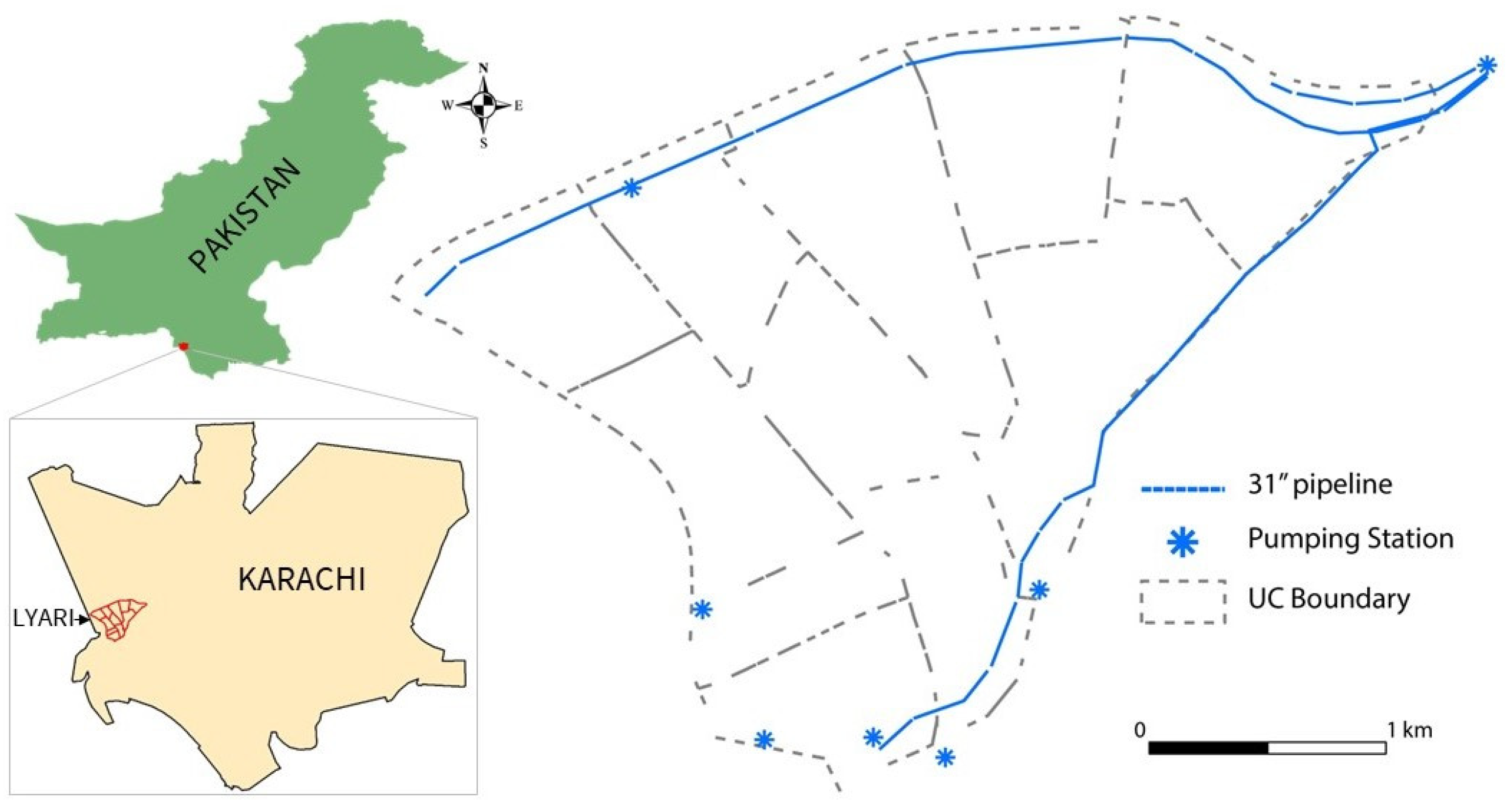
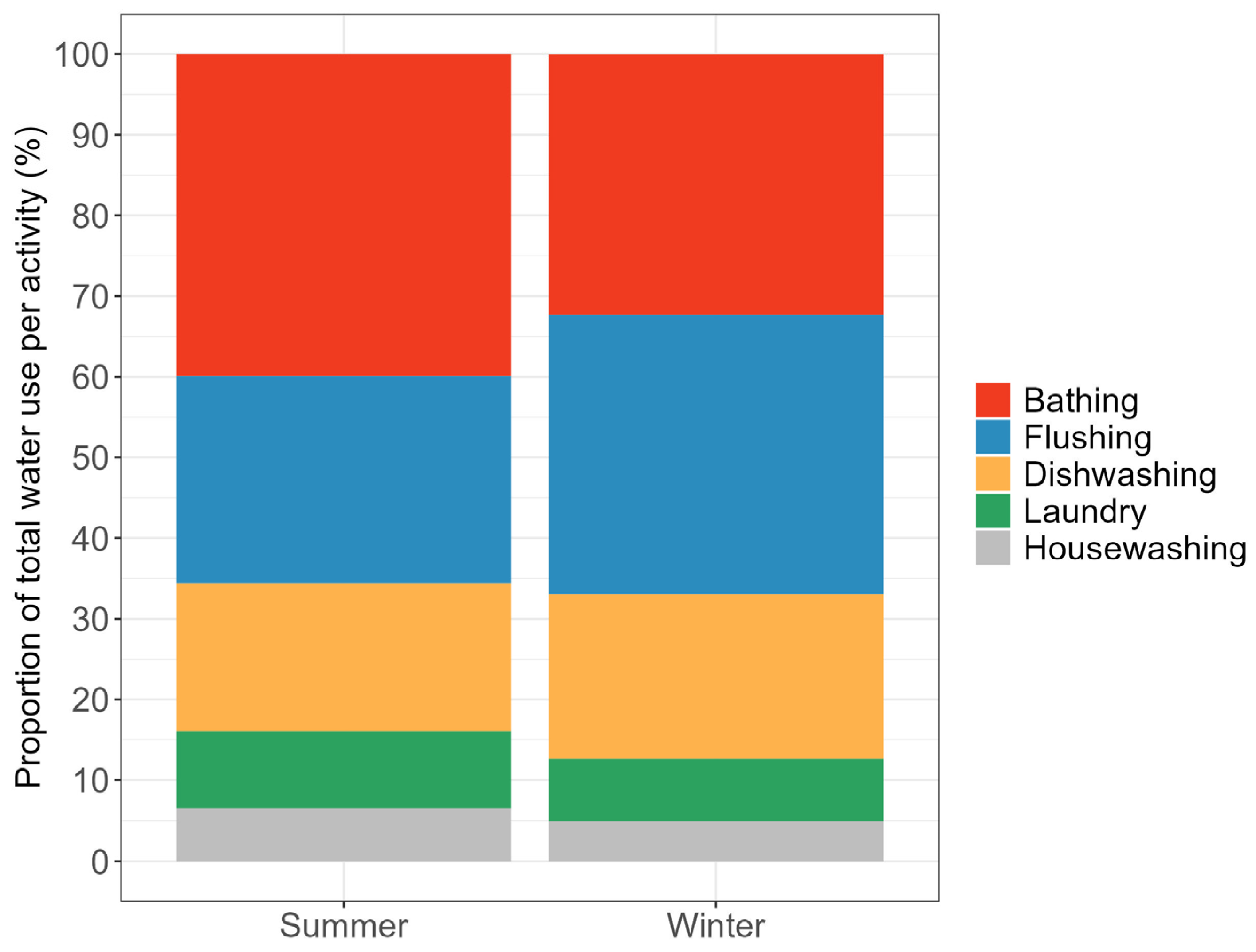
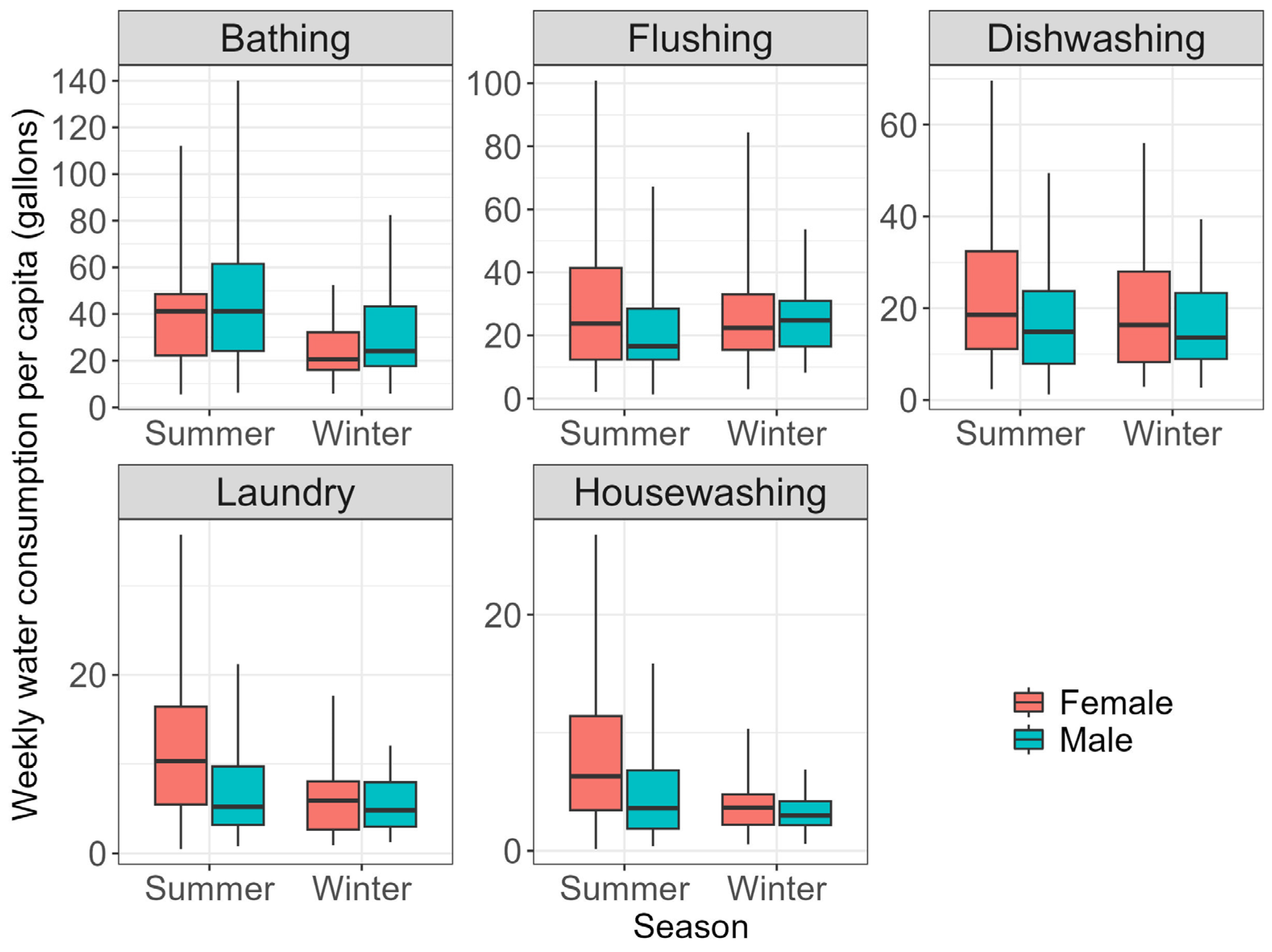
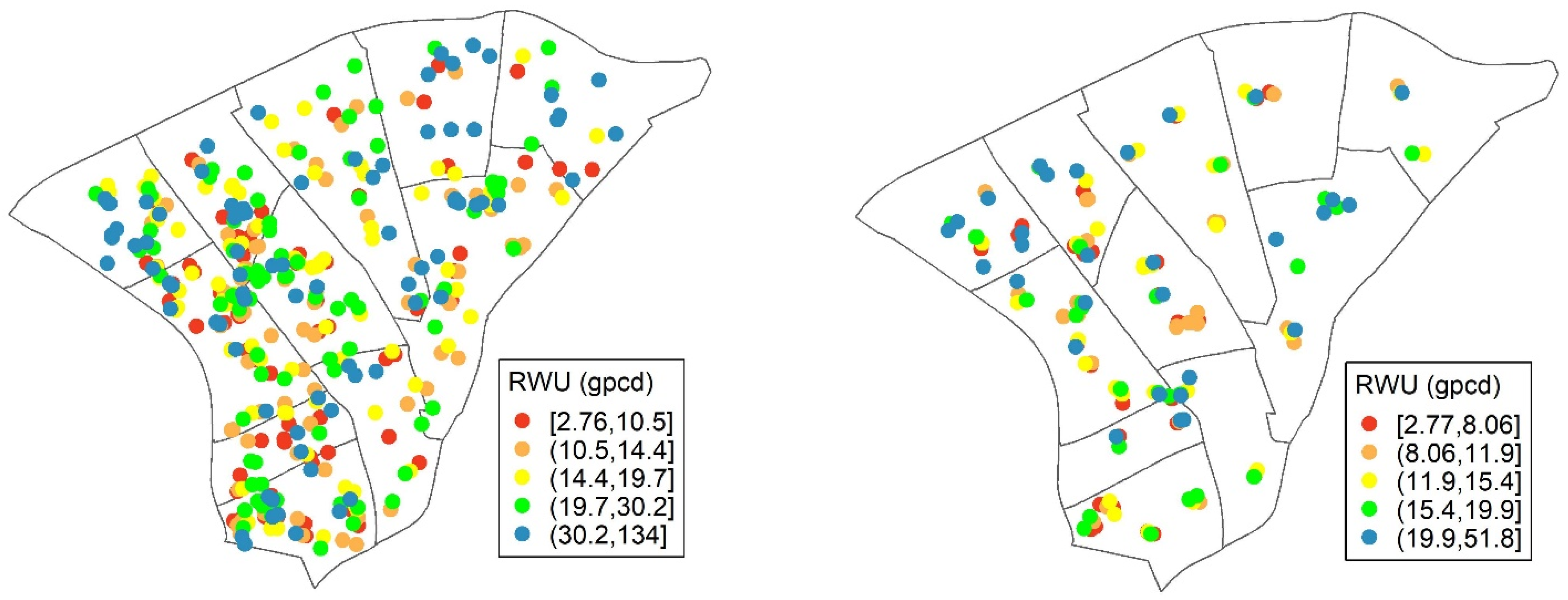
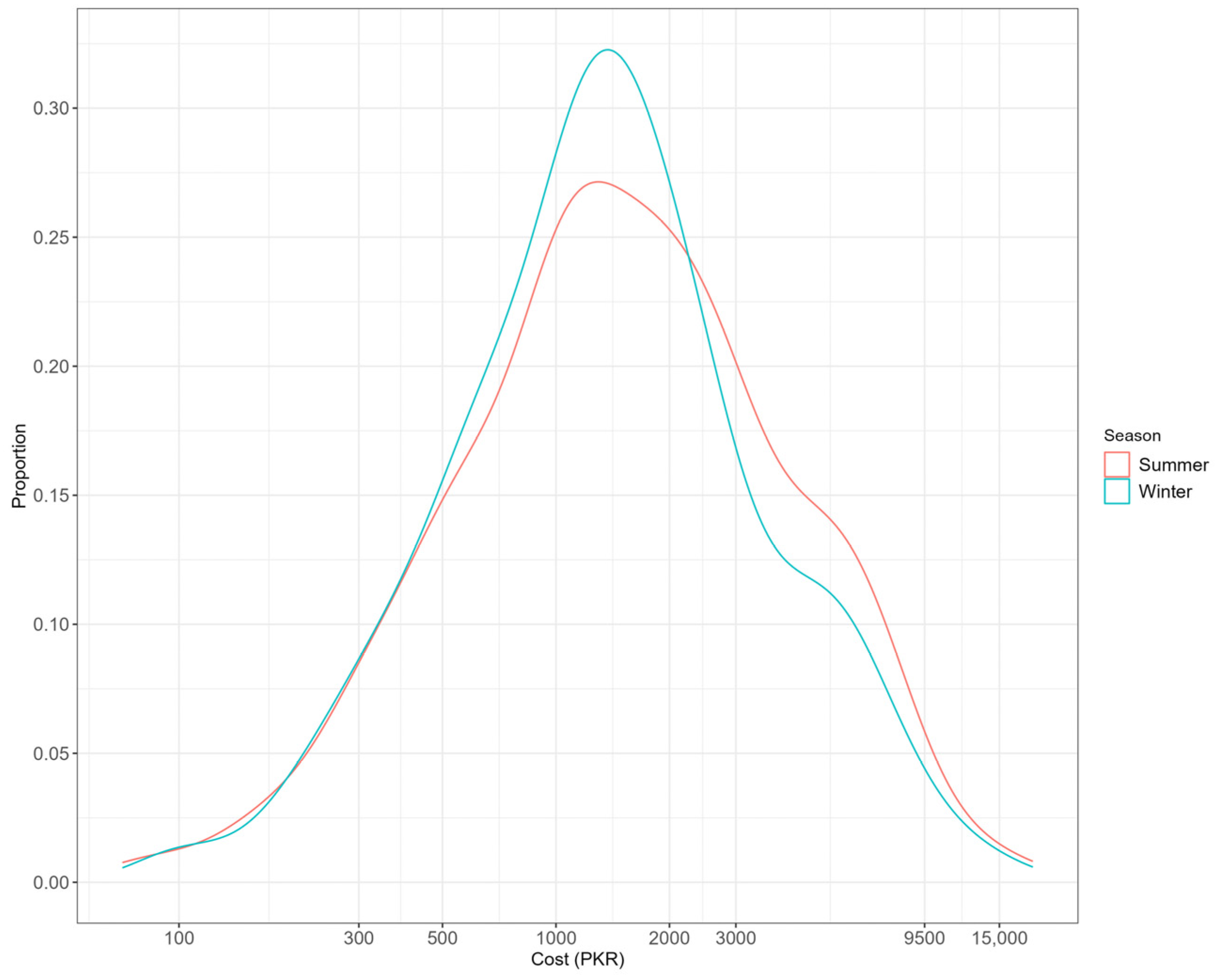
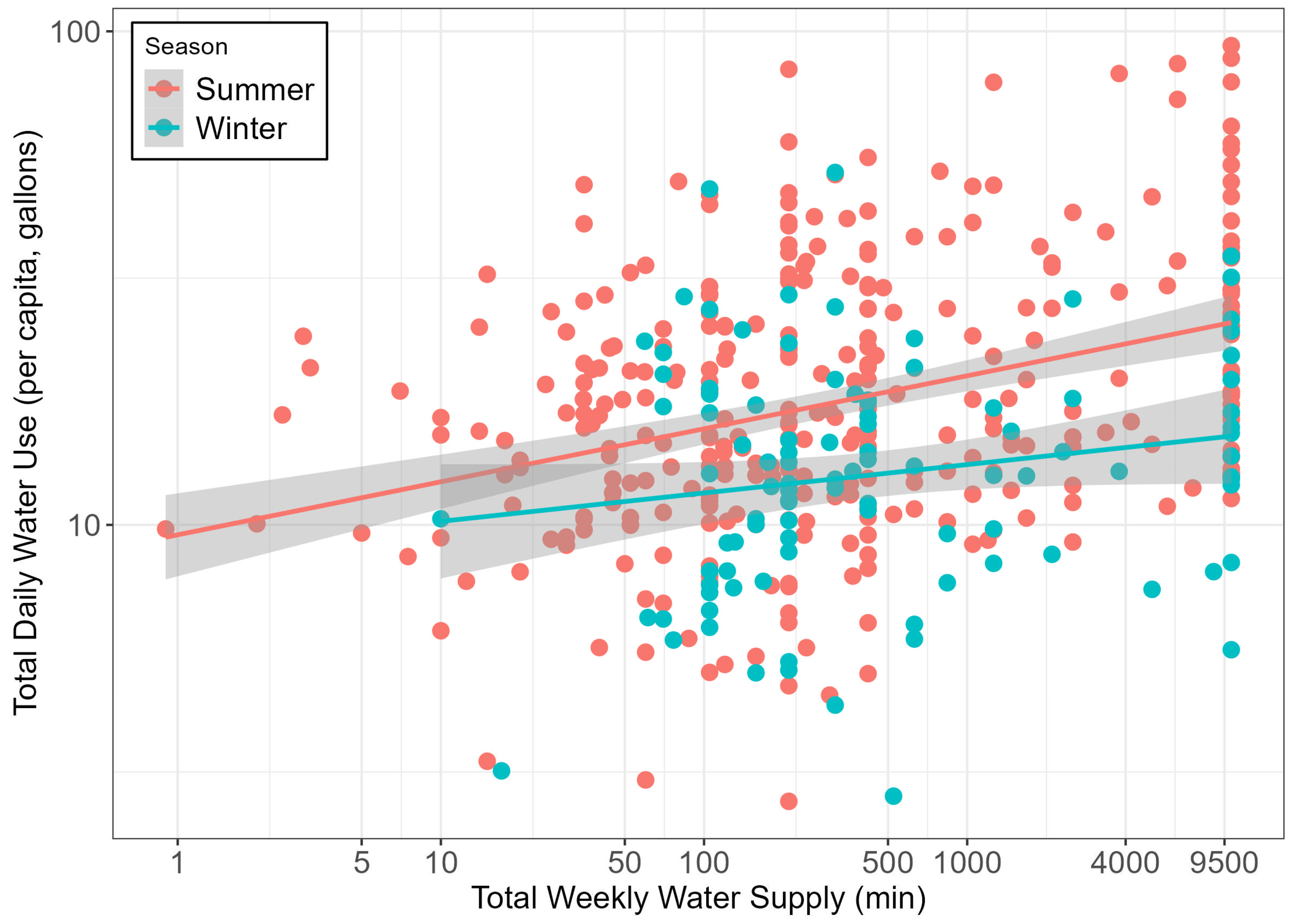
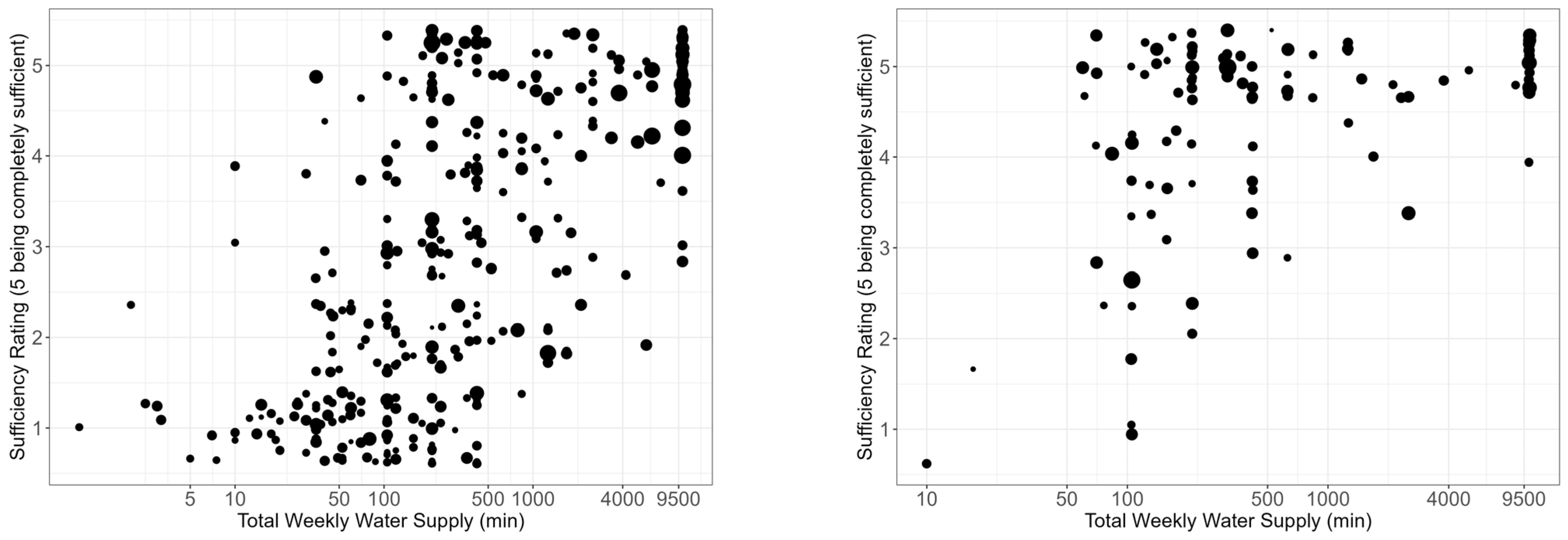
| Summer | Winter | |
|---|---|---|
| Number of surveys | 462 | 162 |
| Male respondents (%) | 37.1 | 38.9 |
| Female respondents (%) | 62.9 | 61.1 |
| Access to pipeline (%) | 92 | 90 |
| Apartment Accommodation (%) | 29.5 | 25.6 |
| Average occupancy | 7.85 | 7.94 |
Disclaimer/Publisher’s Note: The statements, opinions and data contained in all publications are solely those of the individual author(s) and contributor(s) and not of MDPI and/or the editor(s). MDPI and/or the editor(s) disclaim responsibility for any injury to people or property resulting from any ideas, methods, instructions or products referred to in the content. |
© 2023 by the authors. Licensee MDPI, Basel, Switzerland. This article is an open access article distributed under the terms and conditions of the Creative Commons Attribution (CC BY) license (https://creativecommons.org/licenses/by/4.0/).
Share and Cite
Khan, H.F.; Arif, M.A.; Intikhab, S.; Arshad, S.A. Quantifying Household Water Use and Its Determinants in Low-Income, Water-Scarce Households in Karachi. Water 2023, 15, 3400. https://doi.org/10.3390/w15193400
Khan HF, Arif MA, Intikhab S, Arshad SA. Quantifying Household Water Use and Its Determinants in Low-Income, Water-Scarce Households in Karachi. Water. 2023; 15(19):3400. https://doi.org/10.3390/w15193400
Chicago/Turabian StyleKhan, Hassaan Furqan, Muhammad Ali Arif, Sara Intikhab, and Syed Ali Arshad. 2023. "Quantifying Household Water Use and Its Determinants in Low-Income, Water-Scarce Households in Karachi" Water 15, no. 19: 3400. https://doi.org/10.3390/w15193400
APA StyleKhan, H. F., Arif, M. A., Intikhab, S., & Arshad, S. A. (2023). Quantifying Household Water Use and Its Determinants in Low-Income, Water-Scarce Households in Karachi. Water, 15(19), 3400. https://doi.org/10.3390/w15193400






